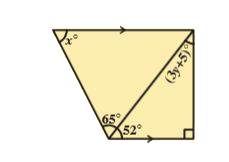Show that the force on each plate of a parallel plate capacitor has a magnitude equal to (12)QE, where Q is the charge on the capacitor, and E is the magnitude of electric field between the plates. Explain the origin of the factor 12.Solution in Tamil
Force =12QE Work done=12V×Q
F×d=12×E.d×Q F=12QE
The physical origin of the factor 12 in the force formula lies in the fact that just outside the conductor, field is E and insde it is zero. So, the average value E2 contributes to the force.
Topper's Solved these Questions
- BOOK - NEW JOYTHI PUBLICATIONCHAPTER - ELECTROSTATIC POTENTIAL AND CAPACITANCEEXERCISE - Practice Problems For Self Assessment23videos
ELECTROSTATIC POTENTIAL AND CAPACITANCE
- BOOK - NEW JOYTHI PUBLICATIONCHAPTER - ELECTROSTATIC POTENTIAL AND CAPACITANCEEXERCISE - Evaluation Questions And Answers41videos
ELECTROSTATIC POTENTIAL AND CAPACITANCE
- BOOK - NEW JOYTHI PUBLICATIONCHAPTER - ELECTROSTATIC POTENTIAL AND CAPACITANCEEXERCISE - Competitive Exam Corner22videos
ELECTROSTATIC POTENTIAL AND CAPACITANCE
- BOOK - NEW JOYTHI PUBLICATIONCHAPTER - ELECTROMAGNETIC WAVES EXERCISE - COMPETITIVE EXAM CORNER16videos
ELECTROMAGNETIC WAVES
- BOOK - NEW JOYTHI PUBLICATIONCHAPTER - MAGNETISM AND MATTEREXERCISE - COMPETITIVE EXAM CORNER13videos
MAGNETISM AND MATTER
Similar Questions
Calculating the work done in eV in carrying a charge +e Coulomb through a potential rise of 100 volts. (1.0eV=1.6×10−19joules)
02:02View SolutionFill up.
 03:09View Solution
03:09View SolutionFrom the figure find x and y.
 03:09View Solution
03:09View SolutionIf the total electromagnetic energy falling on a surface is U, then the total momentum delivered (for complete absorption) is
05:19View SolutionChoose the correct statement .
View SolutionA parallel plate capacitor has an electric field of 10^(5)V//m between the plates. If the charge on the capacitor plate is 1muC , then force on each capacitor plate is-
04:09View SolutionShow that the force on each plate of a parallel plate capacitor has a magnitude equal to (½)QE, where Q is the charge on the capacitor, and E is the magnitude of electric field between the plates. Explain the origin of the factor ½.
View SolutionShow that the force on each plate of a parallel plate capacitor has a magnitude equal to (½)QE, where Q is the charge on the capacitor, and E is the magnitude of electric field between the plates. Explain the origin of the factor ½.
02:36View Solutionदर्शाइए की एक समान्तर पट्टिका संधारित्र की प्रत्येक पट्टिका पर बल का परिमाण 12QE हैं, जहाँ Q संधारित्र पर आवेश हैं और E पट्टिकाओं के बीच विघुत क्षेत्र का परिमाण हैं। घटक 12 के मूल को समझाइये।
View SolutionShow that the force on each plate of a parallel plate capacitor has a magnitude equal to (1/2) QE, where Q is the charge on the capacitor , and E is the magnitude of electric field between the plates . Explain the origin of the factor 1/2.
03:35View SolutionA parallel plate capacitor has an electric field of 10^(5)V//m between the plates. If the charge on the capacitor plate is 1muC , the force on each capacitor plate is
03:42View SolutionShow that the force on each plate of a parallel plate capacitor has a magnitude equal to (1)/(2)QE , where Q is the charge on the capacitor and E is the magnitude of electric field between the plates. Explain the origin of the factor (1)/(2) .
03:45View SolutionShow that the force on each plate of a parallel plate capacitor has a magnitude equal to (1//2) QE, where Q is the charge on the capacitor, and E is the magnitude of electric field between the plates. Explain the origin of the factor 1//2 .
View SolutionShow that the force on each plate of a parallel plate capacitor has a magnitude equal to (1//2) QE, where Q is the charge on the capacitor, and E is the magnitude of electric field between the plates. Explain the origin of the factor 1//2 .
02:41View SolutionShow that the force on each plate of a parallel plate capacitor has a magnitude equal to (1/2) QE, where Q is the charge on the capacitor, and E is the magnitude of electric field between the plates. Explain the origin of the factor 1/2.
05:24View Solution

